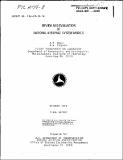| dc.contributor.author | Odoni, Amedeo R. | en_US |
| dc.contributor.author | Simpson, R. W. | en_US |
| dc.contributor.other | United States. Federal Aviation Administration | en_US |
| dc.contributor.other | United States. Dept. of Transportation | en_US |
| dc.contributor.other | Massachusetts Institute of Technology. Flight Transportation Laboratory | en_US |
| dc.date.accessioned | 2012-01-06T06:47:30Z | |
| dc.date.available | 2012-01-06T06:47:30Z | |
| dc.date.issued | 1979 | en_US |
| dc.identifier | 06451420 | en_US |
| dc.identifier.uri | http://hdl.handle.net/1721.1/67941 | |
| dc.description | Cover title | en_US |
| dc.description | October 1979 | en_US |
| dc.description | Includes bibliographical references (p. B1-B32) | en_US |
| dc.description.abstract | Abstract from Technical Report Documentation Page: This report is intended to serve as a guide to the availability and capability of state-of-the-art analytical and simulation models of the National Airspace System (NAS). An extensive literature search produced a listing of 230 reports potentially containing technical descriptions of models developed during the last decade. These reports are classified into primary categories based on applicability of the model to various aspects of the NAS. Capacity/delay models are classified as capacity-oriented runway, delay-oriented runway, complete airport, terminal airspace. air route traffic (including communications), controller workload and performance, and models of major segments of the NAS. Reports describing models primarily concerned with safety-related measures and noise-related measures are categorized separately. Reports were initially screened to eliminate those known to have been superseded by a subsequent report, and those containing inadequate or inconsequential technical information concerning models. The remaining reports (approximately 180) were subjected to a detailed review. The results of this review are documented for each of the 50 distinct models described by the selected reports. Information contained in each model review includes report ID, abstract, input/output parameters, computer-related characteristics, assumptions, quality of documentation, extent of validation, and an evaluation of the model's usefulness and limitations. Another part of the report contains a comparative evaluation of models in the same primary category. These evaluations present an overview of the models contained in each category, summarize the main features of the best models, and document the conclusions and recommendations regarding the models best suited for specific applications. | en_US |
| dc.description.sponsorship | Prepared for U.S. Dept. of Transportation, Federal Aviation Administration, Office of Systems Engineering Management | en_US |
| dc.format.extent | viii, 314, A1-A4, B1-B32, C1-C4 p | en_US |
| dc.publisher | Cambridge, MA : Flight Transportation Laboratory, Dept. of Aeronautics and Astronautics, Massachusetts Institute of Technology ; 1979 | en_US |
| dc.relation.ispartofseries | FTL report (Massachusetts Institute of Technology. Flight Transportation Laboratory) ; R79-8 | en_US |
| dc.subject | Air traffic control | en_US |
| dc.subject | Airports | en_US |
| dc.subject | Mathematical models | en_US |
| dc.subject | Traffic control | en_US |
| dc.title | Review and evaluation of national airspace system models | en_US |
| dc.type | Technical Report | en_US |
